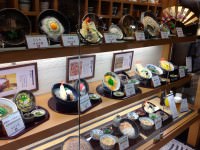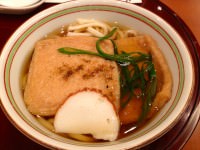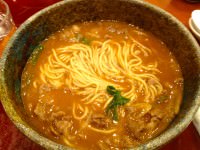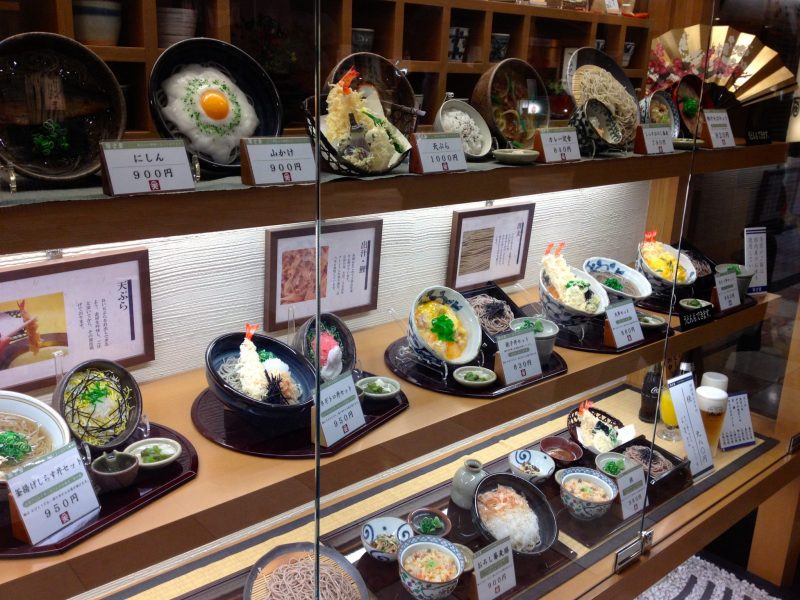
If you’re looking for a quick, tasty and inexpensive meal in Japan, noodle shops are the places to look for. Although, you don’t have to look very hard because they are everywhere. Walking into a noodle shop in Japan and ordering noodles is like walking into a Starbucks and ordering a cup of coffee. There are many different kinds and styles available to choose from. Initially, it may seem a little overwhelming, but most noodle shops will have plastic food models you can point to.
The intent of this blog is to introduce you to some of the different options available. While you may not be able to walk into a noodle shop and order the equivalent to a caffeine-free, non-fat, extra foam latte with an extra shot, hopefully this will give you enough information to explore this Japanese staple on your next (or first) trip to Japan.
Before starting the meat of the blog, I want to answer two questions regarding noodles in Japan we get all the time on our tours:
– Is it OK to slurp noodles in Japan? Not only is it OK, it is expected. First of all, slurping will cool down hot noodles. And it is said the added oxygen will enhance the taste. (Every time I eat noodles in Japan, I always apologize to my mother who told me never to do that.)
– Is it OK to pick up the bowl and drink the soup broth directly from the bowl? Once again, the answer is yes. You will be given a small spoon to use for the soup broth, but picking up the bowl is much easier and faster.
Hot vs. Cold
Most people think that only hot noodles are available, but there are a number of cold noodle dishes available. As much as I like noodles (I could eat noodles every day), I have a hard time eating a bowl of hot noodles on a hot summer day. Cold noodles can be very refreshing during the hot summer months.
Noodle Types

While there are many different noodles available, these are the main types available.
Udon
These thick, white noodles made from wheat flour look and taste similar to the noodles you would find in mom’s chicken noodle soup.
Soba
Soba is the same thing as buckwheat flour. Made from the flower of a plant, these noodles are thinner, usually gray in color and are served both hot and cold.
Ramen
These came from China, and are made from eggs.
Soumen
These are thinner versions of the udon noodles, and are served literally on ice during the summer months.
Varieties
Here are just a few of the common types of noodle dishes you might find in a common noodle shop.

Kake – Udon or soba noodles served in a hot fish-broth based soup.
Kake-nori – Udon or soba noodles served in a hot fish-broth based soup with strips of seaweed added.
Zaru – Udon or soba noodles served cold and dipped into a sauce before eating (one of my personal favorites in the summer months)
Tanuki – Udon or soba noodles served in a hot fish-broth based soup with panko or tempura crumbs added
Kitsune – Udon or soba noodles served in a hot fish-broth based soup with sweetened strips of deep-fried tofu
Ebiten – Udon or soba noodles served in a hot fish-broth based soup with shrimp tempura added
Oroshi – Udon or soba noodles served with hot or cold fish-broth based soup with grated daikon (radish) added
Niku Udon – Udon noodles served with hot fish-broth based soup with seasoned beef strips added
Chikara Udon – Udon noodles served with hot fish-broth based soup with slices of mocha (rice cake) added
Curry – Udon or soba noodles served in a hot fish-broth based soup with curry powder added (Another one of my personal favorites, but only during the winter months)
Miso Ramen – Ramen noodles served in a hot fish and pork-based soup with miso paste added
Shouyu (soy sauce) Ramen – Ramen noodles served in a hot fish and pork-based soup soup with soy sauce added
Shio (salt) Ramen – Ramen noodles served in a hot fish and pork-based soup with salt added
As with all foods in Japan, as you travel around Japan you will find regions with their own specialties. And this applies to noodles as well. For example, Shinshu soba is popular in the Nagano area, Sanuki Udon is popular in the Takamatsu area, Miso Ramen is popular in Sapporo and Champon (a Chinese influenced Ramen) and Sara Udon is popular in Nagasaki to name just a few. It is always best to go with the local specialty. There is a reason why it is popular, and there are noodle shop owners who have spent their life in the pursuit of the perfect bowl of noodles with typical Japanese dedication.





